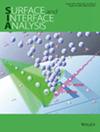利用离子注入金属标准品对二次离子质谱测量进行定量
IF 1.8
4区 化学
Q4 CHEMISTRY, PHYSICAL
引用次数: 0
摘要
本研究采用二次离子质谱(SIMS)分析方法对核聚变相关材料中的相关元素进行定量分析。为此,通过离子注入法制作了内部标准,以避免该技术众所周知的基质效应。其中,铬是以 12 MeV 的能量植入高纯度的铁和钨基质以及硅控制基质中的。后者应用实验和半经验方法确定植入的铬浓度。具体来说,IBA 技术卢瑟福背散射光谱法(RBS)提供了定量结果,高剂量和低剂量分别为 3.1 × 1019 at/cm3 和 1.6 × 1019 at/cm3。铁基质和瓦基质中铬的 SIMS 深度剖面图显示,两种基质上的离子注入深度均接近 2 μm,这与之前通过物质中的离子停止和范围(SRIM)模拟进行的计算结果一致。SIMS 曲线的整合与植入离子的已知浓度之间的相关性导致了每种基质的校准曲线,通过这种相对灵敏度系数(RSF)获得了 SIMS 定量方法。此外,通过将商用铁铬合金与本研究中的铬植入铁基质进行比较,对该方法进行了交叉检验,结果表明需要生产铬浓度更高的标准物质。本文章由计算机程序翻译,如有差异,请以英文原文为准。
Quantification of secondary ion mass spectrometry measurements by using ion‐implanted metallic standards
This research addresses an analytical methodology to quantify elements of interest in fusion‐relevant materials using secondary ion mass spectrometry (SIMS). For this purpose, internal standards have been fabricated by ion implantation to avoid the well‐known matrix effect of this technique. In particular, chromium has been implanted at an energy of 12 MeV using two fluences in high‐purity iron and tungsten matrices together with Si control substrates. The latter were applied to determine the Cr concentration implanted through experimental and semiempirical methods. Specifically, the IBA technique Rutherford backscattering spectrometry (RBS) provided the quantitative results being 3.1 × 1019 at/cm3 and 1.6 × 1019 at/cm3 for the high and low dose, respectively. The SIMS depth profiles of Cr for the Fe and W matrices established an ion implantation depth close to 2 μm on both substrates in agreement with the calculations previously performed by Stopping and Range of Ions in Matter (SRIM) simulations. Correlation between the integration of SIMS profiles and known concentrations of the implanted ion resulted in the calibration curve for each matrix, obtaining the SIMS quantification approach by means of this relative sensitivity factor (RSF). Additionally, a cross‐check of the method by comparing commercial Fe‐Cr alloys with the Cr‐implanted Fe matrices of the present study pointed out the need to produce standards with higher chromium concentrations.
求助全文
通过发布文献求助,成功后即可免费获取论文全文。
去求助
来源期刊

Surface and Interface Analysis
化学-物理化学
CiteScore
3.30
自引率
5.90%
发文量
130
审稿时长
4.4 months
期刊介绍:
Surface and Interface Analysis is devoted to the publication of papers dealing with the development and application of techniques for the characterization of surfaces, interfaces and thin films. Papers dealing with standardization and quantification are particularly welcome, and also those which deal with the application of these techniques to industrial problems. Papers dealing with the purely theoretical aspects of the technique will also be considered. Review articles will be published; prior consultation with one of the Editors is advised in these cases. Papers must clearly be of scientific value in the field and will be submitted to two independent referees. Contributions must be in English and must not have been published elsewhere, and authors must agree not to communicate the same material for publication to any other journal. Authors are invited to submit their papers for publication to John Watts (UK only), Jose Sanz (Rest of Europe), John T. Grant (all non-European countries, except Japan) or R. Shimizu (Japan only).
 求助内容:
求助内容: 应助结果提醒方式:
应助结果提醒方式:


